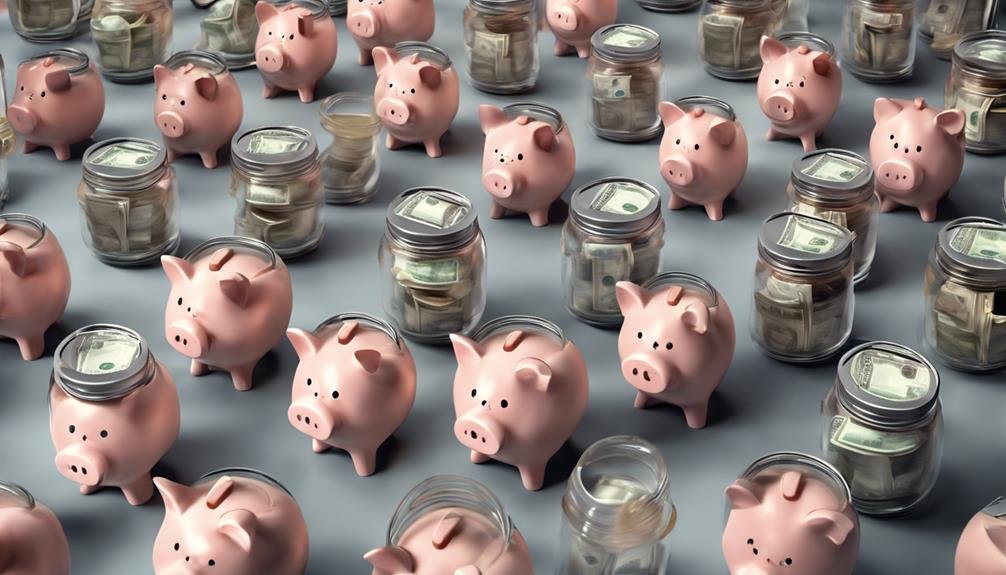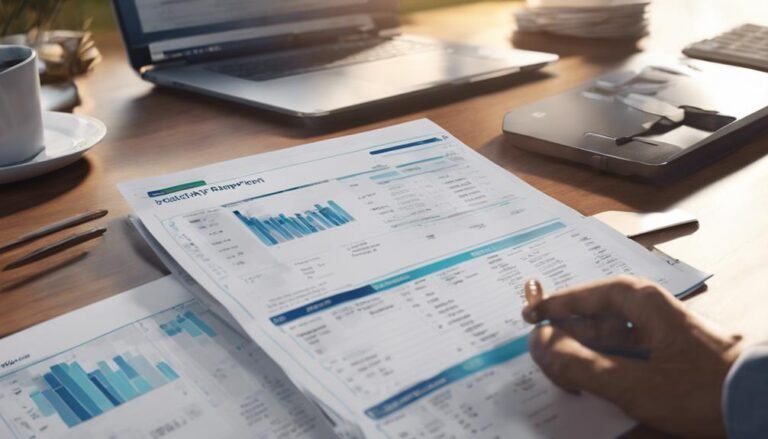Emergency Fund: How Much Should You Save?
When planning your emergency fund, aim to save an amount equal to 3 to 6 months' living expenses. This cushion helps navigate unexpected financial storms without derailing your stability. Consider factors like high-priority expenses and job stability to determine the right size for your fund. Regularly reassess and adjust your savings target as circumstances evolve. By setting a realistic goal tailored to your financial situation, you guarantee preparedness for any unforeseen events. Remember, the key is to have a strong financial safety net to weather any unexpected challenges.
Key Takeaways
- Save 3 to 6 months of living expenses.
- Consider high-priority expenses like debt.
- Factor in job stability and unforeseen costs.
- Adjust fund size for life changes.
- Reassess regularly for financial preparedness.
Importance of an Emergency Fund
Having an emergency fund is vital for financial stability and peace of mind. Life is unpredictable, and unexpected expenses can arise at any moment. These could range from medical emergencies to sudden car repairs or even unexpected job loss. By having a financial cushion in the form of an emergency fund, you can navigate these unforeseen circumstances without derailing your overall financial security.
An emergency fund provides a sense of security, knowing that you have a safety net to fall back on when needed. It eliminates the stress and anxiety that often accompanies financial emergencies, allowing you to focus on finding solutions rather than worrying about how to make ends meet.
Additionally, having an emergency fund is an essential component of future planning. It ensures that you can continue to meet your financial obligations and work towards your long-term goals without being derailed by unexpected setbacks. Essentially, an emergency fund isn't just about dealing with the present but also about safeguarding your future financial well-being.
Factors to Consider
When determining how much to save in your emergency fund, it's essential to take into account several key factors that can impact your financial security and preparedness.
One of the primary considerations is your emergency fund size. This amount should typically cover 3 to 6 months' worth of living expenses to provide a financial cushion in case of unexpected events like medical emergencies or job loss.
Additionally, your savings priorities play a significant role in determining the size of your emergency fund. If you have high-priority expenses such as debt repayments or dependents, you may need to save a larger amount to make sure you can weather any financial storms that come your way.
Recommended Savings Guidelines
When determining your emergency fund savings goal, it's crucial to take into account various factors such as your monthly expenses, job stability, and potential unexpected costs. Understanding how these elements influence the amount you need to save can help you set a realistic target.
Remember to regularly reassess and adjust your emergency fund as life circumstances change to make sure you're adequately prepared for any financial emergencies.
Savings Target Calculation
To determine your savings target, follow recommended guidelines based on your current financial situation and future goals. Start by calculating your monthly expenses, including rent or mortgage, utilities, groceries, insurance, and other essential costs.
A common recommendation is to save three to six months' worth of expenses for your emergency fund. However, if you have dependents or an unstable income, consider saving closer to six months' worth. This amount provides a cushion in case of sudden job loss, medical emergencies, or unexpected home repairs.
Emergency situations can arise unexpectedly, so having a solid savings target is vital for financial stability. By carefully evaluating your monthly expenses and the potential risks you might face, you can determine an appropriate savings goal.
Factors Influencing Amount
Take into account the factors that impact the recommended amount for your emergency fund to make sure you're adequately prepared for unexpected financial challenges. When determining your emergency fund size, consider your monthly expenses, job stability, health concerns, and any potential major expenses on the horizon. Ideally, aim to save at least three to six months' worth of living expenses in your emergency fund. However, if you have dependents, a high-deductible health plan, or an irregular income, you may want to save more to guarantee greater financial security.
Your savings goals should align with your individual circumstances. Factors such as the industry you work in, the stability of your job, and any potential health issues can influence the amount you should save. For example, individuals in industries with high turnover rates may want to aim for a larger emergency fund.
Adjusting for Life Changes
Consider adjusting your emergency fund savings guidelines to account for significant life changes and maintain adequate financial preparedness for unexpected circumstances.
Life events such as marriage, having children, purchasing a home, or changing jobs can greatly impact your financial needs. It's essential to reassess your emergency fund to make sure it aligns with your current situation.
When experiencing changing circumstances like a new job with different income levels or a medical condition that requires ongoing expenses, it's wise to adjust your savings goals accordingly.
Experts recommend having three to six months' worth of living expenses in your emergency fund, but this may need to be increased based on your individual circumstances.
Tailoring the Fund to Your Needs
To tailor your emergency fund effectively, consider customizing the fund size to match your specific financial needs. Aligning your emergency fund with your financial goals guarantees that you have the right amount saved for unexpected expenses.
Personalized Fund Size
Adapting your emergency fund size to your specific financial circumstances and lifestyle is essential for ensuring adequate protection against unforeseen expenses. A customized approach to determining the right fund size involves evaluating various factors unique to your personal circumstances.
Consider aspects such as your monthly expenses, job stability, number of dependents, and any potential high-cost risks, like health issues or car repairs.
To tailor your emergency fund effectively, start by analyzing your average monthly spending. A common recommendation is to save three to six months' worth of expenses, but this may vary based on your individual needs.
For instance, if you have a stable job and minimal financial obligations, saving three months' worth of expenses could be sufficient. However, if you have dependents or work in a volatile industry, aiming for six months or more might be wiser.
Financial Goal Alignment
Aligning your emergency fund to your financial goals and needs is essential for providing the right level of protection against unexpected expenses.
When considering emergency scenarios, such as job loss, medical emergencies, or unexpected home repairs, it's vital to assess your individual situation to determine an appropriate savings balance.
To tailor your emergency fund to your needs, start by evaluating your monthly expenses, debt obligations, and any potential risks you may face.
For example, if you have a stable job and minimal debt, a smaller emergency fund may suffice. However, if you're self-employed or have dependents, you may need a more robust savings cushion.
Strategies for Building Your Fund
Consider incorporating a vital monthly contribution to your emergency fund as a key strategy for steadily building your financial safety net.
To start, set savings milestones to track your progress and stay motivated. Budgeting tips like automating transfers from your checking to your emergency fund or cutting back on non-essential expenses can help you free up funds for this purpose.
As your emergency fund grows, consider exploring investment options to potentially increase its value over time. While maintaining liquidity is essential for emergency funds, certain low-risk investment vehicles like high-yield savings accounts or short-term CDs can offer a slightly higher return compared to traditional savings accounts.
Remember, the primary goal of your emergency fund is accessibility in times of need, so gradually introduce investment elements as your fund reaches a comfortable level.
Reassessing and Adjusting Over Time
To guarantee the effectiveness of your emergency fund, regularly review and adjust your savings goals and strategies as your financial situation evolves.
It's important to adapt your emergency fund to changes in income, expenses, and overall financial health. Here are some key points to keep in mind:
- Fund growth: As your income increases or decreases, reassess the size of your emergency fund. Aim to have 3-6 months' worth of expenses saved up, but adjust this target if your financial situation changes.
- Savings flexibility: Be open to adjusting your savings contributions based on your current needs. If you have extra funds available, consider boosting your emergency savings. Conversely, during leaner times, you may need to temporarily reduce your savings rate.
- Emergency expenses: Regularly review your list of potential emergency expenses and adjust it as needed. This will make sure that your emergency fund covers all necessary costs.
- Investment opportunities: Evaluate if there are investment opportunities that could potentially boost your emergency fund's growth without sacrificing safety.
Regularly reassessing and adjusting your emergency fund will help you stay prepared for unexpected financial challenges.
Frequently Asked Questions
Can I Use My Emergency Fund for Non-Emergencies?
Using your emergency fund for non-emergencies blurs its boundaries. To maintain financial discipline, reserve it solely for unexpected crises like medical expenses or job loss. Keep non-urgent expenses separate to guarantee financial security.
Should I Invest My Emergency Fund for Higher Returns?
When considering your emergency fund for investments, remember: "Don't put all your eggs in one basket." Balance risk assessment with your liquidity needs. Explore investment options for higher returns, but keep long-term goals in mind.
How Do I Handle Unexpected Medical Expenses?
When unexpected medical expenses arise, health insurance plays a vital role in managing costs. Confirm your coverage is thorough. Budget planning is essential to handle these expenses efficiently without compromising your financial stability.
Can I Use Credit Cards Instead of an Emergency Fund?
Using credit cards as a primary emergency fund isn't ideal. High-interest rates can lead to debt spirals. Maintain a savings cushion for unexpected expenses. It's about balancing savings and debt wisely for financial stability.
What if I Can't Meet the Recommended Savings Guidelines?
If you can't meet the recommended savings guidelines, consider alternative options like starting with lower amounts. Adjusting your expectations based on financial struggles is important. Even a small emergency fund is better than none.
Conclusion
As you navigate the unpredictable waters of life, think of your emergency fund as a sturdy lifeboat, ready to keep you afloat when unexpected storms hit.
By following recommended savings guidelines and tailoring the fund to your specific needs, you can guarantee that you have the financial resources to weather any crisis that comes your way.
Remember, building and maintaining your emergency fund is like investing in your own peace of mind and security.








